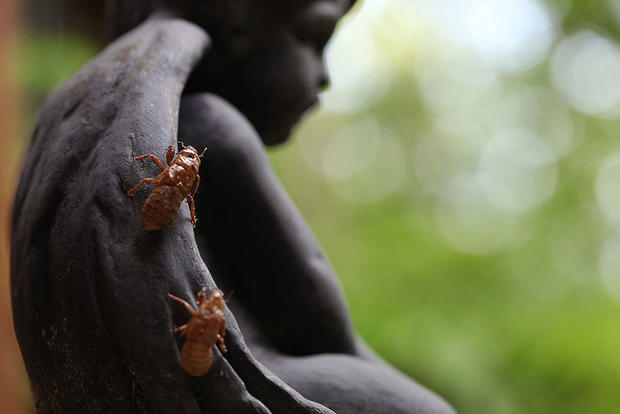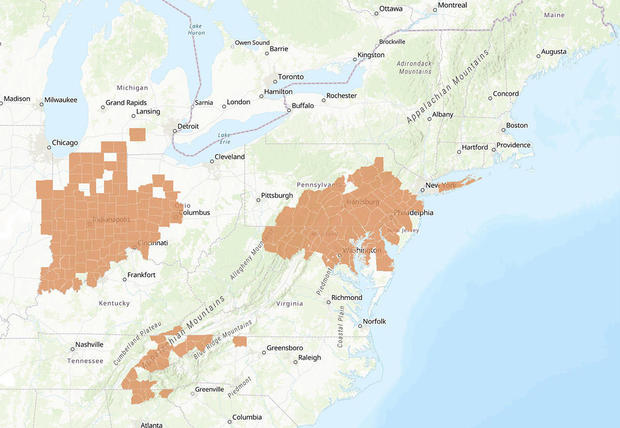What is Brood X, the U.S. cicada infestation coming in 2021?
They're big. They're incredibly loud. And they're coming by the billions.
Meet Magicicada cassinii, better known as the cicada. Every year, a relatively small number of these insects emerge from the ground in the eastern United States. But once every 17 years, a truly massive brood of cicadas arrives in the mid-Atlantic and Midwest, filling the air with a deafening mating hum that can reach up to 100 decibels.
That phenomenon is named Brood X, or the Great Eastern Brood. It's set to return in May 2021. For the five to six weeks that they're above ground, the live cicadas — and their crunchy, discarded exoskeletons — will be impossible to miss.
Here's everything you need to know about this rare phenomenon... and what it means for you and your plants.
What is Brood X, anyway?
Scientists group cicadas based on the year they emerge as adults after spending years developing underground. Brood X is the name for the big generation of cicadas due in the spring of 2021, just as in 2004 and 1987.
Theoretically, there should be 17 different generations of 17-year cicada, each linked to a different geographic zone and a different emergence year. For example, Brood IX, the brood that emerged in 2020, was localized to parts of Virginia, West Virginia and North Carolina.
A few of these broods have never been formally observed, suggesting that they may have gone extinct long ago. (One of these "missing" broods, Brood XI, was last seen in Connecticut in 1954.)
The coming Brood X (that's Brood 10 in Roman numerals) is the most widespread and prolific of the known generations. Through history, it has appeared as far west as Missouri, as far south as Georgia, as far north as Michigan and as far east as Long Island, New York.
You can see the areas with the most frequent sightings in the map below.
Why do they show up once every 17 years?
Most insects, love them or loathe them, make annual appearances in our homes and gardens. So why do cicadas only show up in 17-year cycles?
As it turns out, those long cycles are part of the cicada's evolutionary strategy that dates back 1.8 million years, to the Pleistocene Epoch. Back then, summers could be unpredictably cold in the eastern United States. That's a problem for cicadas: If the temperature lingers too long below 68 degrees, it gets too cold for them to mate and survive.
So cicadas evolved different cycle lengths to improve their odds of survival. A brood can't survive a cold summer above ground, but surviving a cold summer below ground is no problem. The less often cicadas emerge from the earth, the lower their odds of being wiped out by an unusually cold summer.
The exact reason behind the number 17 is unknown, but scientists have a few theories. One idea suggests that the unusual, prime-numbered lifecycle prevents generations of cicadas from run-ins with the lifecycles of wasps that prey on them. Another theory says the prime-numbered cycle reduce the likelihood that 17-year cicadas will mate and hybridize with cicadas of different species or generations.
Such a hybridization would reduce the size of these generations — bad news for a species that needs large numbers to survive.
Why are there so many of them?
It's not easy being a cicada.
Once a cicada emerges above ground, it faces no shortage of predators. Birds, reptiles, fish, spiders, wasps and even household pets all see cicadas as protein-packed snacks. Many predators will completely change their behaviors during cicada years just to feed on them.
Making matters worse for individual insects is the fact that they have virtually no way of fending these predators off. Cicada are big and slow. And despite having wings, they don't fly especially well. If something wants to eat a cicada, chances are, it will.
So the only serious evolutionary defense cicadas have against extinction is their sheer numbers. To survive, cicadas need to show up in such massive numbers that their many, many predators just can't eat them all.
What should I do to prepare my plants for the swarm?
Let's be honest: There's not a whole heck of a lot you can do to avoid the giant mass of cicadas if you live in one of the affected areas — there will be billions of them.
Cicadas won't hurt most plants. The bugs are, however, a danger to young trees, especially fruit trees.
"Don't plant next spring, because these trees are going to simply get hammered next year when those cicadas show up," University of Maryland entomologist Mike Raupp told WTOP News in May 2020. Trees planted in 2020 will be in danger, as well.
If you've recently planted a tree, it's not too late to save it from the coming swarm -- if you hurry. Skip the pesticides, Raupp says, and cover your young trees with netting by the end of April. This will keep the cicadas from laying their eggs in the branches.
You should use "fine netting with net sizes about maybe a centimeter or less, and cover those trees entirely. This will protect those trees." When in doubt, though, skip the planting until 2022.
Are humans in any danger? What about pets?
The good news is that cicadas won't bite you unless they mistake you for a plant, they won't decimate crops like locusts do, and they don't spread disease. They're not poisonous, either, so there's no worry if your dog or cat eats one. (Just be careful they don't gorge themselves, as cicadas' hard exoskeletons and wings can cause pets to choke.)
Cicadas are safe for people to eat, too, if you're feeling adventurous.
What about my house? How do I clean up after billions of cicadas?
More good news: You won't need any special equipment to endure the summer of Brood X. Cicada carcasses can emit a stink after a while, so you might want to keep an outdoor broom and dustpan handy for daily patio sweeps.
Experts advise paying special attention to rooftop gutters, which can grow clogged with cicada parts during large brood cycles. And if you can stomach the sight (and scent) of them, you may want to consider letting the little fellows decompose; their bodies make for decent composting material.
Will they stick around?
After mating and laying eggs in the branches of trees, this brood will die off. The cicadas that hatch in 2021 will drop to the ground and burrow into the earth for 17 years. There, they'll feed on the fluids in tree roots until they emerge to breed in May 2038.
And so the cycle repeats.









